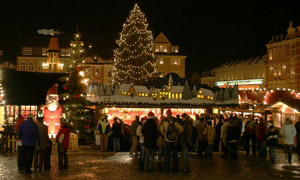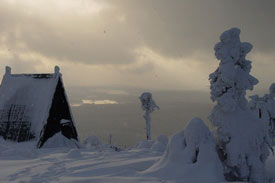The German Erzgebirge Region
 The Erzgebirge region in Germany has become very popular and world known for its creation of beautiful and whimsical nutcrackers, smoker men, Christmas pyramids and candle arches. This region, located on the eastern side of Germany, is mountainous hence the name Erzgebirge which translates to “Ore Mountains”. The Erzgebirge region is a low mountain range and the climate is highly influenced by the bitterly cold winds from Russia. The highest mountain is the Keilberg Mountain which reaches up at 4081 feet high. There are approximately one million inhabitants in the Erzgebirge region. The largest city, Freiberg, boasts around 42,000 inhabitants.
The Erzgebirge region in Germany has become very popular and world known for its creation of beautiful and whimsical nutcrackers, smoker men, Christmas pyramids and candle arches. This region, located on the eastern side of Germany, is mountainous hence the name Erzgebirge which translates to “Ore Mountains”. The Erzgebirge region is a low mountain range and the climate is highly influenced by the bitterly cold winds from Russia. The highest mountain is the Keilberg Mountain which reaches up at 4081 feet high. There are approximately one million inhabitants in the Erzgebirge region. The largest city, Freiberg, boasts around 42,000 inhabitants.
During the cold winter months, the Erzgebirge region is a highly popular tourist attraction. With the more than 100 museums and the wonderful snow for skiing, as well as the world famous Christmas Fairs, tourism reaches millions of visitors each year.
Seiffen, Olbernhau and Marienberg cities are highly popular for their craftsmanship and their Christmas traditions which are centuries old.
The land area of the Erzgebirge region is approximately 90 miles long and 30 miles wide and the landscape is one of the most beautiful in all of Europe. Before the turn of the 12the century, settlement in the Erzgebirge region was difficult due to the winter climate. During the 15th century, however, settlements were sparked due to large deposits of silver and tin that were discovered in the area. During the 16th century, the Ore Mountains – Erzgebirge region became very popular and very wealthy as miners worked to collect the silver and tin. More settlers arrived each year in hopes of sharing the wealth from this beautiful region.
During the 19th century, however, the mining industry slowly trickled to a stop and miners were forced to find other ways of earning a living. The very last silver mine was closed in 1913 and although some mines were re-opened during World War I and World War II, they did not stay open for long and soon the miners were searching for work again.
Today the Erzgebirge region is alive with ancient castles and ruins as well as palaces and churches that reflect the days of wealth and prosperity in the region. Many traditions in the Erzgebirge region were begun during the mining days and are still carried out today.
 After the fall of the mining industry in the Ore Mountains miners were forced to find other ways in which to support themselves and their families. Many miners had hobbies that included woodcarving. These traditions of hand carving date back to around the 15th century when miners would create toys and other needed items for their homes. With the fall of the mining industry, many miners decided to try their hand at creating wooden collectibles and other items of use to sell at local fairs and markets. More and more workshops opened up and more and more miners became highly skilled at the art of creating beautiful wooden treasures. Soon the mining industry was all but forgotten and Erzgebirge was once again on its way to prosperity, only this time it was due to the skill and talent of the inhabitants and their creations of beautiful and exquisite wooden figurines and ornaments.
After the fall of the mining industry in the Ore Mountains miners were forced to find other ways in which to support themselves and their families. Many miners had hobbies that included woodcarving. These traditions of hand carving date back to around the 15th century when miners would create toys and other needed items for their homes. With the fall of the mining industry, many miners decided to try their hand at creating wooden collectibles and other items of use to sell at local fairs and markets. More and more workshops opened up and more and more miners became highly skilled at the art of creating beautiful wooden treasures. Soon the mining industry was all but forgotten and Erzgebirge was once again on its way to prosperity, only this time it was due to the skill and talent of the inhabitants and their creations of beautiful and exquisite wooden figurines and ornaments.
During the Communist reign in Eastern Germany from 1949 until 1990, many private workshops were forced to close. After the reunification of Germany in 1990, however, they re-opened and once again began manufacturing wooden creations that were awe inspiring. Although some owners left the Erzgebirge area during the Soviet reign and began their companies in West Germany, such as Steinbach and Christian Ulbricht, after the reunification process was completed in 1990, these companies built new plants in the Erzgebirge – Ore Mountains area and began to operate from both locations.
Although the history is one filled with trials and life-altering decision making, there are 10 or more large manufacturers of German artifacts in the German Erzgebirge region today. These manufacturers offer a wide selection of products such as nutcrackers, smoker men or incense burners, Christmas pyramids, music boxes and the beautiful and well known candle arches. There are smaller workshops which specialize in specific wooden creations that are also highly popular and offer exclusive selections. KWO Olbernhau and Seiffener Volkskunst have established smaller workshops in the Erzgebirge region and offer a wonderful selection of exclusive wooden creations.
The traditions from those earlier years are still alive and well in the Erzgebirge region. Woodcarving and turning on a lathe and ring are still very common procedures used today. The ring turning technique was invented in the Erzgebirge region during the 19th century. There are several museums and Christmas fairs that draw visitors to the Erzgebirge region every year. The Erzgebirge or Ore Mountains region is located only one hour away from Dresden which makes it a wonderful tourist’s destination any time of the year, however, during the Christmas season the traditions for centuries past come to life and visitors are awed by the beauty that the Erzgebirge region has to offer.

